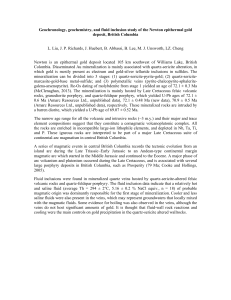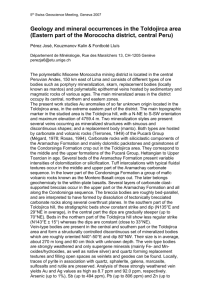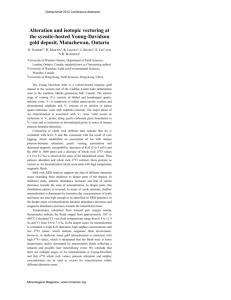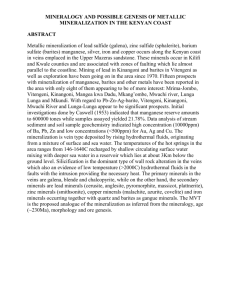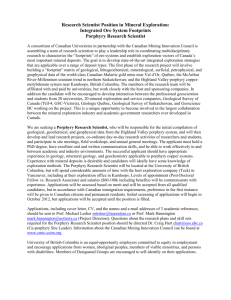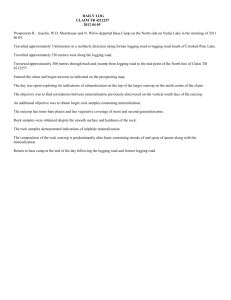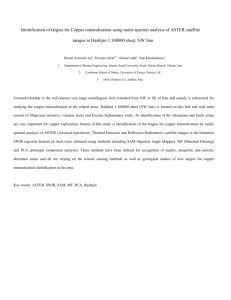Abstract Title - SWISS GEOSCIENCE MEETINGs
advertisement
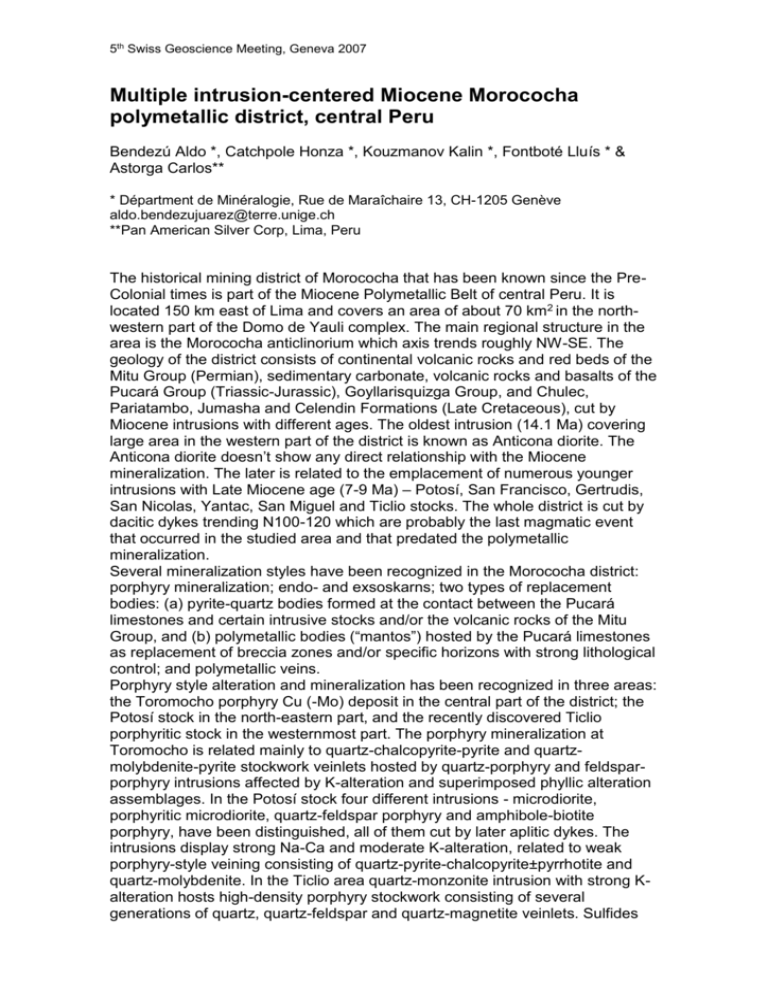
5th Swiss Geoscience Meeting, Geneva 2007 Multiple intrusion-centered Miocene Morococha polymetallic district, central Peru Bendezú Aldo *, Catchpole Honza *, Kouzmanov Kalin *, Fontboté Lluís * & Astorga Carlos** * Départment de Minéralogie, Rue de Maraîchaire 13, CH-1205 Genève aldo.bendezujuarez@terre.unige.ch **Pan American Silver Corp, Lima, Peru The historical mining district of Morococha that has been known since the PreColonial times is part of the Miocene Polymetallic Belt of central Peru. It is located 150 km east of Lima and covers an area of about 70 km2 in the northwestern part of the Domo de Yauli complex. The main regional structure in the area is the Morococha anticlinorium which axis trends roughly NW-SE. The geology of the district consists of continental volcanic rocks and red beds of the Mitu Group (Permian), sedimentary carbonate, volcanic rocks and basalts of the Pucará Group (Triassic-Jurassic), Goyllarisquizga Group, and Chulec, Pariatambo, Jumasha and Celendin Formations (Late Cretaceous), cut by Miocene intrusions with different ages. The oldest intrusion (14.1 Ma) covering large area in the western part of the district is known as Anticona diorite. The Anticona diorite doesn’t show any direct relationship with the Miocene mineralization. The later is related to the emplacement of numerous younger intrusions with Late Miocene age (7-9 Ma) – Potosí, San Francisco, Gertrudis, San Nicolas, Yantac, San Miguel and Ticlio stocks. The whole district is cut by dacitic dykes trending N100-120 which are probably the last magmatic event that occurred in the studied area and that predated the polymetallic mineralization. Several mineralization styles have been recognized in the Morococha district: porphyry mineralization; endo- and exsoskarns; two types of replacement bodies: (a) pyrite-quartz bodies formed at the contact between the Pucará limestones and certain intrusive stocks and/or the volcanic rocks of the Mitu Group, and (b) polymetallic bodies (“mantos”) hosted by the Pucará limestones as replacement of breccia zones and/or specific horizons with strong lithological control; and polymetallic veins. Porphyry style alteration and mineralization has been recognized in three areas: the Toromocho porphyry Cu (-Mo) deposit in the central part of the district; the Potosí stock in the north-eastern part, and the recently discovered Ticlio porphyritic stock in the westernmost part. The porphyry mineralization at Toromocho is related mainly to quartz-chalcopyrite-pyrite and quartzmolybdenite-pyrite stockwork veinlets hosted by quartz-porphyry and feldsparporphyry intrusions affected by K-alteration and superimposed phyllic alteration assemblages. In the Potosí stock four different intrusions - microdiorite, porphyritic microdiorite, quartz-feldspar porphyry and amphibole-biotite porphyry, have been distinguished, all of them cut by later aplitic dykes. The intrusions display strong Na-Ca and moderate K-alteration, related to weak porphyry-style veining consisting of quartz-pyrite-chalcopyrite±pyrrhotite and quartz-molybdenite. In the Ticlio area quartz-monzonite intrusion with strong Kalteration hosts high-density porphyry stockwork consisting of several generations of quartz, quartz-feldspar and quartz-magnetite veinlets. Sulfides 5th Swiss Geoscience Meeting, Geneva 2007 are almost not present in these veins. The porphyry mineralization in the three areas is overprinted by later polymetallic veins and related phyllic to argillic alteration halos and strong silicification. Magnetite and serpentine-dominated exoskarns and garnet-diopside-epidotedominated endoskarns usually form along the contacts of the Late-Miocene intrusions with the Pucará Group and Upper Cretaceous limestones of the Jumasha Formation. In places the skarn bodies host polymetallic mineralization. Replacement pyrite-quartz bodies have been recognized only in the northern sector of the district – the Manuelita, Codiciada and Tashiman areas. There is no strong evidence of structural control on the formation of these bodies. In parts they can reach a size of more than 850 m and a thickness of 100 m. We consider the formation of the replacement pyrite-quartz bodies as a transitional event between the porphyry mineralization and the emplacement of the polymetallic manto bodies and veins. The polymetallic manto bodies occur mainly as a replacement of: (a) tectonic and dissolution breccias overlying the Montero Basalt which is a marker bed into the Pucará Group; (b) overthrust-related breccias; (c) particular horizons of the Pucará Group situated few meters above the contact between the Mitu volcanic rocks and the Pucará limestones; (d) previously skarnified beds of limestones within the lower units of the Pucará Group. The skarn-replacement mantos contain pyrrhotite, chalcopyrite, Fe-rich sphalerite and galena in different proportions, while the breccia-replacement mantos consist of Fe-poor sphalerite, galena, Cu-sulfosalts, rhodochrosite and quartz. Polymetallic veins with the same composition played like feeders for the formation of the manto bodies. The polymetallic veins are the economically most important ore type in the Morococha district. They are fault-controlled and belong to two main systems: (a) normal dextral or sinistral faults striking N60-80, and (b) normal dextral faults striking N20-30. The relative temporal relationship between the two vein systems indicates that the N60-80 system predate the N20-30 system. Field observations in particular places suggest that the N60-80 vein system consists mainly of quartz and pyrite, and the second vein system is enriched in basemetal minerals. The later polymetallic vein system cut all previously described ore body types and temporally corresponds to the latest mineralizing event in the district. In the Morococha area, Late Miocene magmatic activity has produced one of the economically most important polymetallic districts in the Miocene Polymetallic Belt of central Peru. Porphyry mineralization and alteration is overprinted by epithermal style of polymetallic mineralization, thus indicating ore formation in two different environments, separated in time or forming a continuum. Structural data suggest also change in the orientation of the stress regime between the emplacement of the porphyries and the ore formation related to the polymetallic veins. Polymetallic mineralization dominated by Ag, Zn and Pb produced the most of the economic ore in the peripheral part of the district, while the large Toromocho porphyry Cu (-Mo) system dominates its central part.
